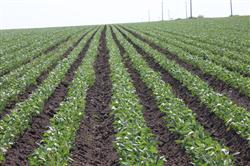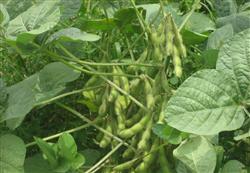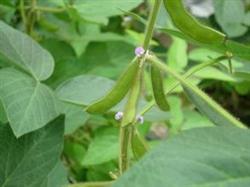How to grow and manage summer soybeans?

How to grow and manage summer soybeans? Please give a detailed introduction that soybean is an important cash crop in agriculture in China. Due to the influence of variety characteristics and climatic conditions, summer soybean can not emerge at the right time, strong seedlings and whole seedlings after sowing, and the growth of seedlings can also be harmed by diseases and insect weeds, resulting in sparse seedlings, weak seedlings, low yield, poor quality and efficiency. It has been proved by many years' practice that the key to growing summer soybean well is to grasp the following technical points. 1. Planting key points (1) selection of suitable varieties and reasonable close planting of summer soybeans should be combined with local Rain Water conditions, variety characteristics and soil fertility to select varieties. For example, varieties with more branches, luxuriant plants and unlimited podding habits should be selected in areas with drought and little rain, while varieties with developed main stems, strong culms and limited podding habits with medium and large grains should be selected in the areas where Rain Water is abundant. There are about 15000 seedlings per mu in high fertility soil and more than 20 000 seedlings per mu in low fertility soil. (2) applying sufficient basal fertilizer to cultivate strong soybean seedlings needs certain nutrients. The application of N, P and K as base fertilizer before sowing can promote seedling growth and Lignification of young stems, so as to promote disease resistance of strong seedlings. Generally, ternary compound fertilizer 40kg (equivalent to pure N3.4kg, pure P3.2kg, pure K3.4kg) or rotten organic fertilizer 1500-2000kg is used as base fertilizer per mu. (3) to prevent waterlogging damage, Kang Sprout, strive to open the field drainage ditch in time after sowing the whole seedling, so that the ditches are connected, the drainage and irrigation is smooth, and there is no stagnant water on the rainfall border surface to prevent rotten seed; when the weather is dry and unable to cultivate, it is necessary to water and produce moisture in time to make soil moisture suitable for soil preparation and sowing; if the weather continues to dry and sow, seedlings still need to be watered at the right time to prevent bean sprouts from dehydrating to cause Kang sprouts. Do not flood irrigation when fighting drought, which will affect the emergence of seedlings. (4) the suitable period of topdressing, foliar spraying and prevention of drought in the later stage is the simultaneous growth of nutrition and reproduction in the early flowering stage, when the nitrogen released by rhizobium in the root system of the plant can not meet its growth needs. Topdressing nitrogen at the early flowering stage can promote the growth of flowers and young pods. Generally sprinkle urea 3.5-5kg per mu while rain, plant growth is too prosperous can be appropriate to reduce the amount or not to apply urea. Foliar fertilizer spraying was used in soybean seedling stage and early flowering stage, respectively, ammonium molybdate diluted to 0.05% murine 0.1% solution or calcium superphosphate diluted to 2% solution, 50kg plus potassium dihydrogen phosphate 150g and urea 100g spray per mu, every 7 days, three times in a row, the positive and negative leaves were sprayed moist, expanded absorption surface, improved fertilizer efficiency, and significantly increased yield. If the weather is dry, the soybean should be watered at the appropriate time from the initial flowering to the pod filling stage to prevent the yield from being affected by drought. 2. Key points of chemical weeding and pest control (1) the soil is closed 3 days after chemical weeding, requiring that the border is smooth, fine soil is uniform, and the soil is moist. 72% ECl00-120ml or 50% Acetochlor ECl00-150ml per mu is used to spray water 30kg. You can also choose 15% fine grass EC75ml plus 25% Huwei AS50-60ml per mu, 48% bentazon AS100ml in the plot with more sedge growth, and spray water 50kg stems and leaves during the 3-leaf stage and 3-5 leaf stage of all kinds of weeds. In order to ensure the quality of chemical weeding, we must use the right amount of medicine, the right amount of water, timely removal, to prevent re-spraying and leakage spraying. (2) Rhizoctonia solani, root rot and white silk disease are easy to occur in soybean seedling stage. Choose 50% carbendazim WP500g or 50% thiram WP400g before planting, stir and dissolve the water 2kg, then evenly mix the seeds 100kg, and then sow the seeds after cooling and drying; or in the true leaf stage of the seedlings, choose 50% thiophanate WP or 65% zinc WPl00g per mu to spray the stems and leaves of water 50kg once. The occurrence of downy mildew and anthracnose can be effectively controlled by topiramate in the full bloom of soybean. (3) when bean plants grow from flowering to pod filling stage, pests such as bridge worm, soybean leaf borer, cotton bollworm, beet armyworm, beet armyworm and Spodoptera litura are easy to occur. These pests occur mixed in the field, the generations overlap, the damage is rampant, and the drug resistance is strong, so the control must be based on the forecast period of the pest; or from the end of July to the beginning of August, special attention should be paid to observe whether there are reticulated and serrated leaves eaten by low-instar larvae in the field, once it is found that it should be controlled in time, once every 7 days, three times in a row. It is recommended that different types of insecticides should be mixed and used alternately each time, so as to prevent pests from developing drug resistance. In the early stage, 2.5% Baode EC, 2.5% Kung Fu EC, 4.5% cypermethrin EC, 5% Yitaibao EC, 40% an Minle EC and 48% Lexbene EC were all diluted 1500 times, and the spray solution was 50kg per mu from 5: 00 p.m. or 6: 00 a.m. to 8: 00 a.m. Try to spray the liquid directly on the insect body to improve the control effect. In the later stage, biological insecticides, such as compound BT emulsion, Bacillus thuringiensis BT preparation and Bacillus thuringiensis, contained 10 billion live spores per gram, diluted 500 to 800 times to water, and sprayed 50kg per mu of stems and leaves. It can also be mixed with any of the above pesticides. Do not mix with fungicides, otherwise there will be no control effect. Click to get more soybean planting technology click to get more grain and oil crop planting technology
- Prev

What to pay attention to when planting soybeans in summer
What should I pay attention to when planting soybeans in summer? Please give guidance to summer planting soybean plant small, short growth period, in order to obtain higher yield in a limited time, field management should be based on promotion, do "three early and two clever". 1. Summer soybean seedlings are short, early seedlings are needed, early seedlings are fixed...
- Next

How to manage the flowering and podding period of summer soybean?
How to manage the flowering and podding period of summer soybean? Please introduce the flowering and podding period of summer soybeans, mainly strive for more flowers, early flowers, full flowers, and prevent the shedding of flowers and pods and the increase of flowers and pods, which is the central task of management in this period. It depends on seedling management, the combination of protection and control, high-yield fields to control mainly, to avoid premature ridge closure, to achieve at the end of flowering.
Related
- The first cup of black tea in spring, the flavor and history of tea gardens in Kenya, Africa
- The computer can not only choose potatoes, but also grow tea rice. AI will grow winter oolong tea champion.
- It is not only the inflated tea bitten by insects, but also engraved with the four seasons tea in Beipu.
- The Oriental Beauty Tea Festival in Zhuxian County takes the stage at the weekend to experience the plus-size feast of oil tea.
- & quot; Oriental Beauty Tea & Exploration of Emei in Hsinchu, the hometown of quot;
- The new variety of strawberry "Tainong 1" dessert is the first choice with mellow aroma. Crimson gorgeous
- History of Tea in Taiwan: from Wild Inner Mountain to Export Tea Garden
- Two types of Taiwan Oriental Beauty Black Tea won the British three-Star Award for Childhood Tea Xiang Zhang Jiaqi changed from pilot to champion tea maker.
- Banana species and varieties: the planting history of Taiwan Xianren banana and dwarf banana is long, is banana disease resistant?
- Coffee planting Technology: Qianjie Coffee from Seedling to harvesting

